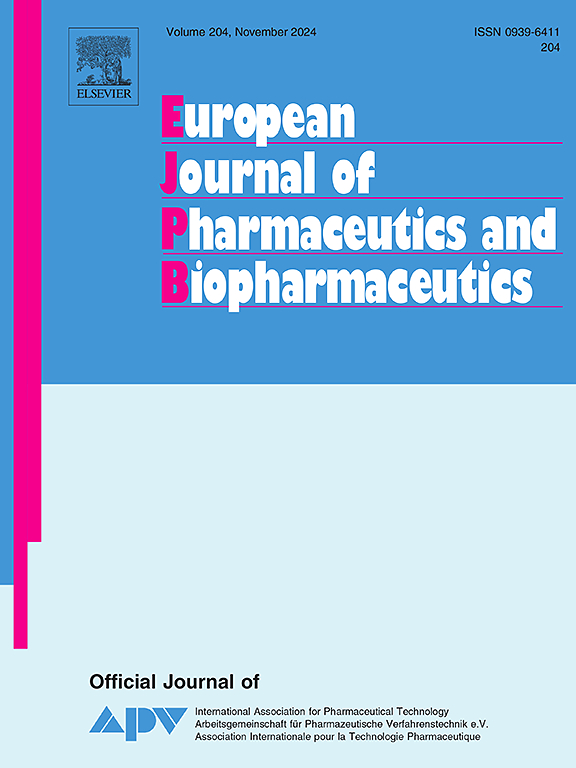Mechanisms of polysorbate 80 oxidation: Acetate and Fe(III) mediated near UV and visible light degradation enhanced by free fatty acids
IF 4.3
2区 医学
Q1 PHARMACOLOGY & PHARMACY
European Journal of Pharmaceutics and Biopharmaceutics
Pub Date : 2025-06-06
DOI:10.1016/j.ejpb.2025.114763
引用次数: 0
Abstract
Polysorbate 80 (PS80) is a widely used nonionic surfactant in biopharmaceutical formulations. PS80 is prone to chemical degradation, potentially resulting in loss of surfactant properties essential for the stability of pharmaceutical formulations. A deep understanding of PS80 stability is critical to maintaining drug efficacy and safety. While general mechanisms of oxidation are known, specific mechanistic information on the initiation of PS80 oxidation in formulations is lacking. Here, we report on novel mechanisms of photo-degradation of PS80 in pharmaceutical buffers such as acetate, succinate, and adipate, containing Fe(III). Photo-degradation was monitored by fluorescence micelle assay (FMA) and mass spectrometry (MS). The mechanistic investigation suggests an intra-micellar PS80 photo-degradation mechanism, wherein buffer-derived carbon-centered radicals, generated from light-induced ligand-to-metal-charge-transfer (LMCT) and decomposition of Fe(III)-carboxylate complexes, enter the PS80 micelles and initiate degradation. Critical for the extent of photo-degradation is the presence of small levels of free fatty acids (FFAs), such as can be present in commercial multi-compendial PS80, facilitating the access of radicals into micelles via complexing with Fe(III) on the micelle surface.

聚山梨酯80氧化机制:游离脂肪酸增强醋酸和铁(III)介导的近紫外和可见光降解。
聚山梨酯80 (PS80)是一种广泛应用于生物制药制剂的非离子表面活性剂。PS80容易发生化学降解,可能导致失去对药物配方稳定性至关重要的表面活性剂特性。深入了解PS80的稳定性对于维持药物的疗效和安全性至关重要。虽然氧化的一般机制是已知的,具体的机制信息的启动PS80氧化的配方是缺乏。在这里,我们报道了PS80在含铁(III)的醋酸盐、琥珀酸盐和己二酸盐等药物缓冲液中光降解的新机制。采用荧光胶束法(FMA)和质谱法(MS)监测光降解情况。机制研究表明,PS80胶束内的光降解机制是由光诱导的配体-金属电荷转移(LMCT)和Fe(III)-羧酸配合物分解产生的缓冲源碳中心自由基进入PS80胶束并引发降解。光降解程度的关键是存在少量的游离脂肪酸(FFAs),例如可以存在于商业多组分PS80中,通过与胶束表面的Fe(III)络合,促进自由基进入胶束。
本文章由计算机程序翻译,如有差异,请以英文原文为准。
求助全文
约1分钟内获得全文
求助全文
来源期刊
CiteScore
8.80
自引率
4.10%
发文量
211
审稿时长
36 days
期刊介绍:
The European Journal of Pharmaceutics and Biopharmaceutics provides a medium for the publication of novel, innovative and hypothesis-driven research from the areas of Pharmaceutics and Biopharmaceutics.
Topics covered include for example:
Design and development of drug delivery systems for pharmaceuticals and biopharmaceuticals (small molecules, proteins, nucleic acids)
Aspects of manufacturing process design
Biomedical aspects of drug product design
Strategies and formulations for controlled drug transport across biological barriers
Physicochemical aspects of drug product development
Novel excipients for drug product design
Drug delivery and controlled release systems for systemic and local applications
Nanomaterials for therapeutic and diagnostic purposes
Advanced therapy medicinal products
Medical devices supporting a distinct pharmacological effect.

 求助内容:
求助内容: 应助结果提醒方式:
应助结果提醒方式:


